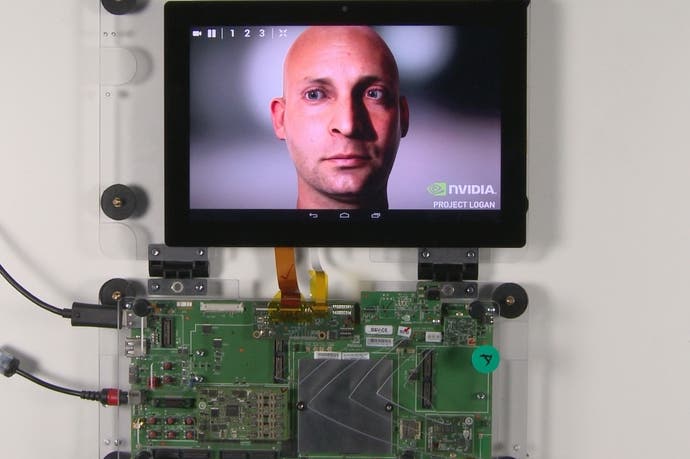Mobile Kepler revealed: more powerful than current-gen console?
Nvidia says its new tablet/smartphone tech outperforms PS3's RSX.
Nvidia has revealed its first working prototype for Project Logan, the next-gen mobile graphics core that scales down its existing PC "Kepler" architecture for smartphones and tablets. Talking bullishly about a potential 5x increase over the iPad 4's GPU power, Nvidia reckons that the raw graphical capabilities of the new hardware exceeds both the RSX chip in the PlayStation 3 and its own 8800 GTX graphics card.
At the heart of Project Logan is a single "SMX" processor, housing 192 CUDA cores and 16 texture mapping units. To put that into perspective, the mobile GT 650M utilised in the Retina Macbook Pro has two SMX units, and easily runs the likes of Battlefield 3 and Crysis 2 at relatively high settings. So with the arrival of Logan in early 2014, will we finally be seeing mobile hardware that can finally exceed the graphical power of current-gen consoles?
Clearly there are a lot of variables that will determine whether that's possible - not least of which will be the clock speed of that single SMX, not to mention the level of bandwidth that is available along with the scale and speed of the attached memory. In the here and now, that information remains undisclosed. On top of that, the surrounding CPU architecture that complements Logan is also unknown, though a revision of the quad-core ARM Cortex A15 hardware found in Tegra 4 seems the most likely option.
While there are still a bunch of questions surrounding the make-up of the Logan platform, what we do have are a brace of exciting demos, kicking off with a mobile take on Nvidia's Faceworks Ira demo, which seeks to render a highly realistic, expressive human face in real-time at 1080p. You can see the Logan version of the demo below, but it's only four months since we saw the same demo running on GTX Titan hardware at GTC 2013. The mobile version has been nipped and tucked in terms of detail level and shader quality, but for technology designed for smartphones and tablets, this is seriously impressive stuff - especially when you realise that the original demo was running on hardware with 14 SMX units, not one.
"Nvidia claims that mobile Kepler matches iPad 4 performance using just a third of the power and that fully unleashed, it's more powerful than PS3's RSX graphics chip."
But there's more. Another old Nvidia demo, first shown on its last-gen Fermi architecture, was ported over to the new mobile Kepler platform. Here we see a Crysis-style island, with impressive water effects, vegetation, hills, mountains and palm trees. Tessellation is showcased here, dynamically increasing geometry and scaling up detail by up to a factor of ten, according to Nvidia. What we're seeing here is established and cutting-edge PC graphics technology migrating across seemingly seamlessly to mobile platforms.
This is all possible due to the range of graphics APIs that Project Logan supports. While current mobile graphics only use the OpenGL ES 3.0 standard, Kepler's PC underpinnings means it additionally supports the likes of DirectX 11 and OpenGL 4.4, making it a good target for Windows RT and Android devices. There's support for Nvidia's own CUDA programming language - not particularly relevant for gaming perhaps, but more useful for coders looking to port existing compute software. However, on a wider scale, support for such a wide range of APIs opens the door to games developers to more easily bring games designed for PC or console into the mobile space.
Overall then, highly impressive stuff, but the question is how much power does Logan require to pull off this kind of performance? Well, let's put this into context. The GT 640M Kepler chip has two SMX core clusters running at 625MHz, drawing 32W at peak. Even assuming linear scaling, you might expect one SMX to draw 16W - way beyond the power envelope of mobile hardware. Nvidia is claiming that the demos seen on this page are drawing around 2-3W of power - a remarkable achievement. In comparison with the iPad 4 GPU - the best mobile graphics hardware on the market right now - Nvidia claims that it achieves in 900mW what the PowerVR hardware requires 2.6W to process. Logan will need to be downclocked significantly to operate on a power-constrained platform like a smartphone, but even if that happens, there should still be a significant increase over iPad 4 performance. On an iPad-style tablet, potentially the sky's the limit, and in terms of computing power at least, we should finally see the current-gen console standard beaten.
"There's more to 'console-quality' performance than just the graphics tech. Bandwidth, memory, CPU power and the efficiency of the graphics API are also key factors."
But there's a big difference between raw graphical power and the ability to run current-gen console games on a mobile platform. We can't help but wonder whether the surrounding architecture is there to be able to run what would be comparatively cutting-edge games on a mobile platform. We've already talked about CPU performance, memory bandwidth and clock-speeds, but let's not forget that mobile APIs and operating systems aren't geared for games in the way that consoles are. PlayStation Vita is now a generation or two behind the latest and greatest Android smartphones, yet there's nothing to match the overall quality of a game like Uncharted: Golden Abyss - that's the difference a dedicated gaming infrastructure brings to the table.
It's also worth bearing in mind that Nvidia isn't operating in a vacuum - competing technologies are on their way. We should finally see the new PowerVR Rogue hardware appearing in this year's iPad refresh, and for a long time now, rumours have circulated that it's set to comprehensively address the lack of computing power compared to the current-gen consoles. Qualcomm is currently in the ascendant, practically owning the high-end Android market with its latest Snapdragon chips, and will clearly be unwilling to relinquish its dominance on the market.
For Nvidia to make a real impact, it'll need to get Logan to market as quickly as possible. Bearing in mind that Tegra 4 has only just arrived, the notion that its successor will be widely available around six months from now seems rather optimistic, but if the product lives up to Nvidia's claims, it could indeed usher in a new era in mobile gaming.
"If mobile Kepler lives up to Nvidia's claims, it could indeed usher in a new era in mobile gaming."




